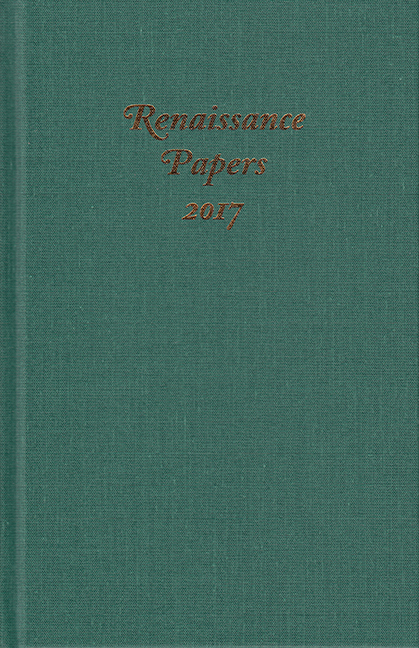Book contents
- Frontmatter
- Contents
- Dedication
- The Contested Pliability of Sacred Space in St. Paul's Cathedral and Paul's Churchyard in Early Modern London
- Classicism from Urbino: The Bichi Chapel Frescoes by Francesco di Giorgio Martini
- Visualizing the Paragone in Francisco de Zurbarán's Crucifixion with a Painter
- A Change in the Making: Shakespeare's Ovidian Sleep of Death and Display
- Old Black Rams and Mortal Engines: Transhumanist Discourse in Othello
- Dying with Speed and Felicity: Humor and Death in Book 3 of the Faerie Queene
- “If Devils Will Obey Thy Hest”: Devils in Dr. Faustus and The French Historie
- Rewriting Lucrece: Intertextuality and the Tale of Lucrece
- Economy and “Honesty” in Thomas Middleton's A Chaste Maid in Cheapside
- Glossing Authorship: Printed Marginalia in Aemilia Lanyer's Salve Deus Rex Judaeorum
- Botany and the Maternal Body in Titus Andronicus
- Unhorsing the Lustiest Challenger: Reflections on Chivalry in Richard II and Henry IV, Part 1
Botany and the Maternal Body in Titus Andronicus
Published online by Cambridge University Press: 04 April 2019
- Frontmatter
- Contents
- Dedication
- The Contested Pliability of Sacred Space in St. Paul's Cathedral and Paul's Churchyard in Early Modern London
- Classicism from Urbino: The Bichi Chapel Frescoes by Francesco di Giorgio Martini
- Visualizing the Paragone in Francisco de Zurbarán's Crucifixion with a Painter
- A Change in the Making: Shakespeare's Ovidian Sleep of Death and Display
- Old Black Rams and Mortal Engines: Transhumanist Discourse in Othello
- Dying with Speed and Felicity: Humor and Death in Book 3 of the Faerie Queene
- “If Devils Will Obey Thy Hest”: Devils in Dr. Faustus and The French Historie
- Rewriting Lucrece: Intertextuality and the Tale of Lucrece
- Economy and “Honesty” in Thomas Middleton's A Chaste Maid in Cheapside
- Glossing Authorship: Printed Marginalia in Aemilia Lanyer's Salve Deus Rex Judaeorum
- Botany and the Maternal Body in Titus Andronicus
- Unhorsing the Lustiest Challenger: Reflections on Chivalry in Richard II and Henry IV, Part 1
Summary
I HAVE always been fascinated by Shakespeare's double vision of the forest in act 2 of Titus Andronicus. In the sudden transformation of the forest from locus amoenus, pleasant place, to locus horridus, fearful place, Shakespeare, as he does throughout the play, is imitating and over-going Ovid, who also uses the locus amoenus to seduce and disarm his readers with a beautiful landscape before shocking them with the violent actions that inevitably occur there. Both writers create “a liminal space where the civilized and the uncivilized intersect, challenging and subverting the expectations of the audience.” But what is most striking to me is how quickly the transformation to violence takes place and that it is largely Tamora, who reconstructs the natural space, manipulating as she does conventional associations of the landscape with the breeding female body.
In a play so characterized by death and unspeakable human atrocity, Titus Andronicus is remarkable for its evocation of nature and for the correspondence that it makes between humans and plants. The play is filled with botanical images and processes. Trees are constantly referenced. Bodies are limbed, lopped, and grafted. Aaron's baby is a blossom. Skin is bark; arms are branches; hands are herbs “meet for plucking up.” People root, rot, and wither. By likening humans to plants, Shakespeare participates in a long tradition, one that links human and botanical reproduction and one that we see repeatedly in other types of texts from the period.
Since Gail Kern Paster's groundbreaking work on the Galenic humoral system and embodiment, scholars have increasingly called attention to the interrelationship between humans and their environment in the early modern period, what Paster characterizes as the “ecology” of the body, an ecology marked by its penetrability, porousness, and instability. Paster's notion of a “psychophysiological reciprocity between the experiencing subject and his or her relation to the world” provides an interesting gloss on Tamora's descriptions of the forest, its “instability and volatility” both reflecting Tamora's emotions and affecting those of her sons. The landscape seethes with vitality here, creating a fluid network of sympathies with the human world far more complex than that suggested by the literary concept of pathetic fallacy.
- Type
- Chapter
- Information
- Renaissance Papers 2017 , pp. 139 - 154Publisher: Boydell & BrewerPrint publication year: 2018



